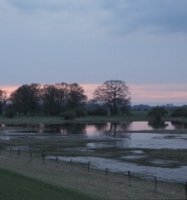 Bildrechte: B. Königstedt
Bildrechte: B. KönigstedtBetween River and Dykes
In many parts the Elbe is bordered by a ‘riparian strip’ of woodland, after which come extensive grasslands which are regularly flooded in spring. Both of these features are characteristic of the region. The terrain is frequently very varied, featuring flood channels and drains, oxbow lakes, depressions and deposits of sandy material.
Northern swans and geese use these areas as resting places, especially at the winter’s end when the grasslands are covered with a shallow layer of floodwater. The spring migration also brings numbers of wading and water fowl, including lapwings (Vanellus vanellus) and many different kinds of duck: mallard (Anas platyrhynchos), wigeon (Anas penelope), garganey (Anas querquedula), teal (Anas crecca), northern shoveler (Anas clypeata), pintail (Anas acuta), pochard (Aythya farina) and gadwall (Anas strepera).
The Elbe lowlands are characterized by various different kinds of floodplain meadow. The diversity of species to be found is highly dependent on the kind of husbandry practised there – whether the vegetation is grazed or mown, when it is mown and whether fertilizer is used. A meadow type which can be regarded as typical for the Middle Elbe is the oxeye daisy and sorrel meadow (Leucanthemum-Rumex thyrsiflorus-society).
In the meadows, which are regularly flooded and mowed, Cnidium-venosae-meadows can be seen as representative habitats worthy of special consideration. However, they are generally mown in spring, which does not suit the typical plants. The Elbe biosphere reserve contains the highest density of such grasslands in the whole of Germany.
The characteristic plant for this type of meadowland is an umbellifer related to parsley, fennel etc. and known in German as the ‘Brenndolde’ (Cnidium dubium). As these plants bloom quite late in the summer, early mowing prevents them from producing flowers – and even if they sprout new flower heads, they do not have enough time to reach maturity. As they can also reproduce via their roots, the plants can survive this treatment for long periods of time and they are still relatively plentiful on the Elbe watermeadows. Other characteristic species for these meadows are meadow-pepper (Silaum silaus), marsh pea (Lathyrus palustris), saw-wort (Serratula tinctoria), spear-leaved skullcap (Scutellaria hastifolia), hedgehyssop (Gratiola officinalis), and fen violet (Viola persicifolia). Many of these species have become rare on account of grazing or mowing and are generally to be found at the edges of the meadows. So by way of providing protection for this habitat type and the endangered species within it, it is important to combine contractually agreed nature conservation with specific measures such as the extensive usage of edge strips, for instance on river and drainage channel banks.
The standing bodies of water of the Elbe floodplain, some of which occasionally dry up in summer, are transformed at Maytime by the white blossoms of the water-crowfoot (Ranunculus aquatilis). Oxbow lakes and other bodies of water which do not dry up are often fully covered by the floating leaves of the white waterlily (Nymphaea alba) and the yellow pond-lily (Nuphar lutea).
There are only remnants of hardwood riparian forests along the Elbe: A mere 50 hectares of the present floodplain can be described as hardwood forest. The characteristic species for these habitats are English oak (Quercus robur), fluttering elm (Ulmus laevis) and ash (Fraxinus excelsior). These riparian forests contain climbing plants which, in some parts, cover the undergrowth and give it the appearance of being dressed in a veil. These include the berry catchfly (Cucubalus baccifer), a plant belonging to the carnation family – its fully developed sepals are reminiscent of a pigeon’s crop, so that its common German name is ‘Taubenkropf’.
 Bildrechte: B. Königstedt
Bildrechte: B. KönigstedtIn many parts the Elbe is bordered by extensive grasslands which are regularly flooded in spring.



 deutsch
deutsch english
english